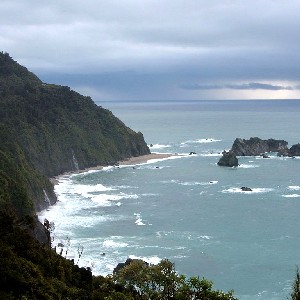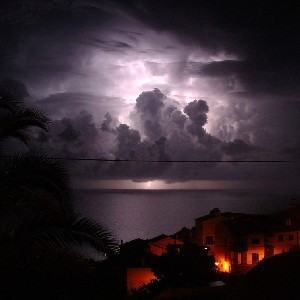Coastal landforms - Coastal features
Dec 2016
Home ›
Planet earth ›
Factors influencing coastal landforms ›
What are landforms? ›
Coastal landforms - Coastal features
Coastal landforms or features are present along any coast. Coastal features are created by the combined natural forces such as tides, waves, currents and weather phenomena. These dynamic natural forces, continuously shaping the shoreline features, create high cliffs and headlands, sloping plains and beaches, bays, coves, caves, arches and stacks along the coast. Seashores can be categorized into two major types, namely, coastal erosion landforms and coastal depositional landforms.
Factors influencing coastal landforms
Coastal features are a dynamic environment are remodeled continuously by many factors and forces. Astronomical tides, waves, storm surges and other weather phenomena have been reshaping coasts by erosion and deposition. The rise and fall of sea levels due to global sea level change or local uplift can give rise to unique features like raised beaches, rias and fjords.Tides also affect the reach of the waves on the shore and influence both deposition as well as erosion. Waves have tremendous energy and great erosive power. Wave erosion gives rise many coastal features like wave-cut platforms, stacks, arches, stumps, cliffs, bays and coves.

Image source: http://en.wikipedia.org/wiki/File:Vizag-Beach.JPG
Image attribution: Sekharyeeti | License: CC BY-SA 3.0
Image attribution: Sekharyeeti | License: CC BY-SA 3.0
Types of coastal landforms
Coastal features, considering the sediment dynamics, can be broadly classified into depositional and erosional landforms.Coastal erosion landforms
Depending upon the type of erosion, amount of erosion, type of rocks involved and the features created, erosional coastal features are categorized as cliffs, bays, coves, stacks, arches etc.High cliffs, headlands and peninsulas
Most of the depositions on the shore are due to erosion of cliffs and headlands. Cliffs are formed where the land dips at a steep angle towards the shoreline. A headland is usually surrounded by sea on three sides. The wave erosion may make the declivity steeper and lead to formation of cliffs. Further wave erosion at cliff-foot of unconsolidated lands can lead to cutting away of material. The wave erosion leaves a portion overhanging which ultimately collapses and is broken into loose debris and sediments. The speed of wave erosion of the coastal landform is depended upon the strength of the surf, type of rocks, the hardness of bedrock and the steepness of declivity.
Bays
Bays are formed where the shore is dispersed with bands of resistant rocks and soft rocks. There is differential erosion and the weak rocks are eroded away with the formation of headlands by the resistant rocks. The eroded rock debris of soft rock formations are carried way and the shoreline retreats landward forming a bay.
Coves
Coves are small narrow, sheltered bays with inlets and creeks. Coves are usually surrounded by hard rock formations. Coves are erosion landforms, formed by differential erosion. When there are soft and hard rocks, the soft racks are eroded faster forming features like circular bays with narrow entrances.
Wave-cut platforms
Wave-cut platforms are formed at the base of cliffs. These wave-cut benches are formed by the wave action on the bed rocks. These coastal landforms may be a few meters to several hundred meters in width. Wave-cut platforms may be present just at the base of the cliff or extend all the way to the base of next cliff.
Sea stacks, arches and stumps
Sea stack are formed when a headland or wave-cut platform is eroded all around. They may have spectacular features and appear as isolated pinnacles. These coastal landforms as they undergo erosion, reach instability and collapse and completely disappear or remain as sea stumps. When the waves erode through a stack, a natural arch is formed. Sea caves are formed when there are areas of weakness on the rock face. These areas erode faster and form features like depressions and caves.
Coastal depositional landforms
Depositional landforms are present at the river mouths. Estuaries, lagoons, barrier islands and river deltas are some of the features of the depositional coastal landforms. The constant transport and deposition of silt and sediments keep the estuary growing and spreading. The size of the delta is directly proportional to the size of the river and the amount of sediments carried by it. The shapes and features of the estuaries are influenced by the water and sediment discharge by the river, waves, tidal currents and storm surges faced by the coastal features.Coastal plains landforms
Coastal plains features are flats where the land gradually descend into the sea. Plains may be formed due to abrasion of loose rock and their deposition. Here the wave action is usually perpendicular to the shoreline and there is continuous and gradual deposition of sediments. Such flats may also form when the sea advances into gently sloping land bordering the sea. Parallel strips of beach and shoreline are formed. Due to constant wind erosion of the beach sand dunes may be formed.
Keywords: coastal, landforms, features.
Google+ page
By Mahmood Syed Faheem

Image: http://en.wikipedia.org/wiki/ File:Knight%27s_Point,_West_Coast.jpg
Image attribution: Swollib |License:CC BY-SA 3.0
Image attribution: Swollib |License:CC BY-SA 3.0

Source: http://en.wikipedia.org/wiki/
File:Thunder_lightning_Garajau_ Madeira_289985700.jpg
Attribution: Don Amaro | License: CC BY 2.0 (as on 2013-08-25)
File:Thunder_lightning_Garajau_ Madeira_289985700.jpg
Attribution: Don Amaro | License: CC BY 2.0 (as on 2013-08-25)
Advertisement